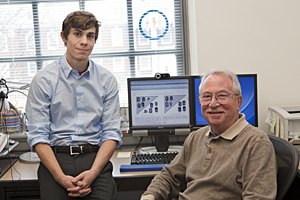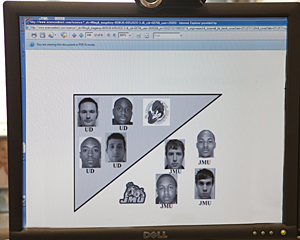

ADVERTISEMENT
- Rozovsky wins prestigious NSF Early Career Award
- UD students meet alumni, experience 'closing bell' at NYSE
- Newark Police seek assistance in identifying suspects in robbery
- Rivlin says bipartisan budget action, stronger budget rules key to reversing debt
- Stink bugs shouldn't pose problem until late summer
- Gao to honor Placido Domingo in Washington performance
- Adopt-A-Highway project keeps Lewes road clean
- WVUD's Radiothon fundraiser runs April 1-10
- W.D. Snodgrass Symposium to honor Pulitzer winner
- New guide helps cancer patients manage symptoms
- UD in the News, March 25, 2011
- For the Record, March 25, 2011
- Public opinion expert discusses world views of U.S. in Global Agenda series
- Congressional delegation, dean laud Center for Community Research and Service program
- Center for Political Communication sets symposium on politics, entertainment
- Students work to raise funds, awareness of domestic violence
- Equestrian team wins regional championship in Western riding
- Markell, Harker stress importance of agriculture to Delaware's economy
- Carol A. Ammon MBA Case Competition winners announced
- Prof presents blood-clotting studies at Gordon Research Conference
- Sexual Assault Awareness Month events, programs announced
- Stay connected with Sea Grant, CEOE e-newsletter
- A message to UD regarding the tragedy in Japan
- More News >>
- March 31-May 14: REP stages Neil Simon's 'The Good Doctor'
- April 2: Newark plans annual 'wine and dine'
- April 5: Expert perspective on U.S. health care
- April 5: Comedian Ace Guillen to visit Scrounge
- April 6, May 4: School of Nursing sponsors research lecture series
- April 6-May 4: Confucius Institute presents Chinese Film Series on Wednesdays
- April 6: IPCC's Pachauri to discuss sustainable development in DENIN Dialogue Series
- April 7: 'WVUDstock' radiothon concert announced
- April 8: English Language Institute presents 'Arts in Translation'
- April 9: Green and Healthy Living Expo planned at The Bob
- April 9: Center for Political Communication to host Onion editor
- April 10: Alumni Easter Egg-stravaganza planned
- April 11: CDS session to focus on visual assistive technologies
- April 12: T.J. Stiles to speak at UDLA annual dinner
- April 15, 16: Annual UD push lawnmower tune-up scheduled
- April 15, 16: Master Players series presents iMusic 4, China Magpie
- April 15, 16: Delaware Symphony, UD chorus to perform Mahler work
- April 18: Former NFL Coach Bill Cowher featured in UD Speaks
- April 21-24: Sesame Street Live brings Elmo and friends to The Bob
- April 30: Save the date for Ag Day 2011 at UD
- April 30: Symposium to consider 'Frontiers at the Chemistry-Biology Interface'
- April 30-May 1: Relay for Life set at Delaware Field House
- May 4: Delaware Membrane Protein Symposium announced
- May 5: Northwestern University's Leon Keer to deliver Kerr lecture
- May 7: Women's volleyball team to host second annual Spring Fling
- Through May 3: SPPA announces speakers for 10th annual lecture series
- Through May 4: Global Agenda sees U.S. through others' eyes; World Bank president to speak
- Through May 4: 'Research on Race, Ethnicity, Culture' topic of series
- Through May 9: Black American Studies announces lecture series
- Through May 11: 'Challenges in Jewish Culture' lecture series announced
- Through May 11: Area Studies research featured in speaker series
- Through June 5: 'Andy Warhol: Behind the Camera' on view in Old College Gallery
- Through July 15: 'Bodyscapes' on view at Mechanical Hall Gallery
- More What's Happening >>
- UD calendar >>
- Middle States evaluation team on campus April 5
- Phipps named HR Liaison of the Quarter
- Senior wins iPad for participating in assessment study
- April 19: Procurement Services schedules information sessions
- UD Bookstore announces spring break hours
- HealthyU Wellness Program encourages employees to 'Step into Spring'
- April 8-29: Faculty roundtable series considers student engagement
- GRE is changing; learn more at April 15 info session
- April 30: UD Evening with Blue Rocks set for employees
- Morris Library to be open 24/7 during final exams
- More Campus FYI >>
2:12 p.m., Nov. 29, 2010----The face is familiar, but ... maybe only if it belongs to someone who's a member of the same group as you, psychologists say.
Previous studies have found that a person is more likely to recognize a photo of a face as familiar if that person belongs to the same racial group as the one in the picture. But now, a University of Delaware graduate student says other “same-group” characteristics also influence recognition and can be just as important as racial identification.
That finding has earned Eric Hehman, a doctoral student in the Department of Psychology, a national research award for his work exploring what characteristics of a person cause others to remember or forget having seen his face before.
“We found that white students [participating in the research] recognized white faces better than they did black faces,” Hehman said. “But when we identified the faces as either University of Delaware students or James Madison University students, the UD students recognized other UD students better than the JMU students, regardless of their race.”
Previous studies of facial recognition have indicated that “you can't overcome the racial distinctions” that people make, Hehman said, but his research contradicts that.
Hehman, whose adviser is Samuel Gaertner, professor of psychology, received the Psi Chi/American Psychological Association's Edwin B. Newman Graduate Research Award for the paper he published about the research in the Journal of Experimental Social Psychology. His citation for the award calls it “an outstanding research paper.”
For his study, Hehman showed UD undergraduates a total of 40 photos of faces -- displayed eight at a time on a computer screen -- and told them they'd be asked later if they recognized them. After a break, they were shown numerous faces one at a time and asked to identify each as one they had seen before or one that did not seem familiar.
When the photos were grouped by race, that characteristic played a significant role in recognition, but when they were grouped by university affiliation, that affiliation became key. Hehman said the psychological mechanism that causes differences in whether a face is recognized is unknown, but he suspects that people remember those who belong to their own group because those people seem more likely to affect or interact with them.
“It seems that the people we aren't as familiar with -- who aren't part of 'our group' -- we aren't able to distinguish that well,” Gaertner said. “That group might be a racial group, but in this study, the participants were re-categorizing the faces using their university affiliation instead of race to identify them as belonging to a particular group.”
Gaertner's research specialty is intergroup relations and exploring how to reduce prejudice and discrimination. Hehman, who said his own research interest resulted from time spent in the military, described his “grandiose long-term goal” as decreasing “the frequency and intensity of intergroup aggression and conflict.”
Article by Ann Manser
Photos by Ambre Alexander


